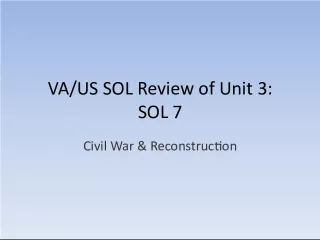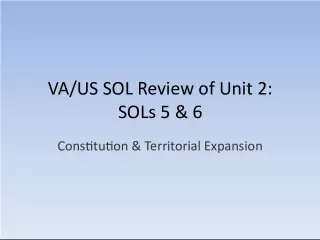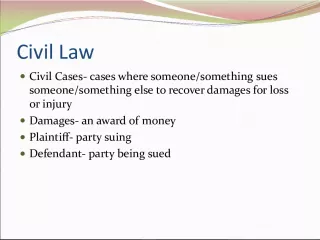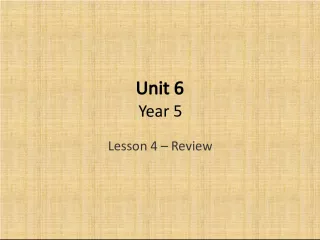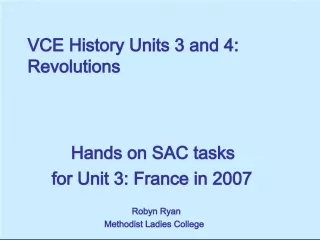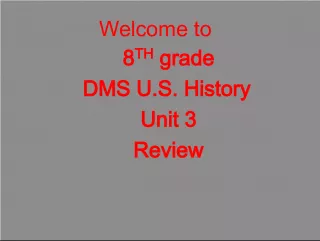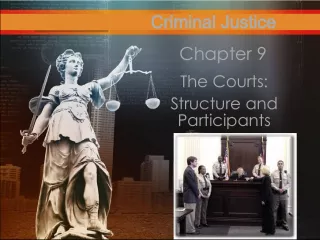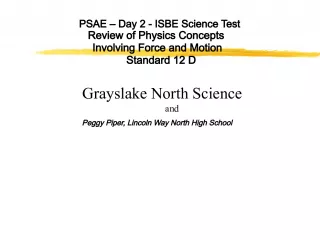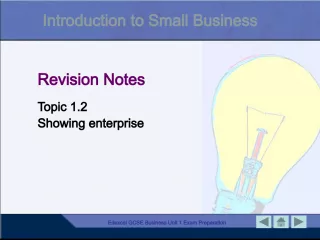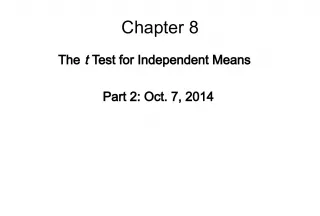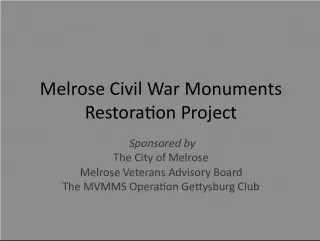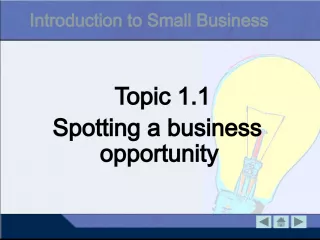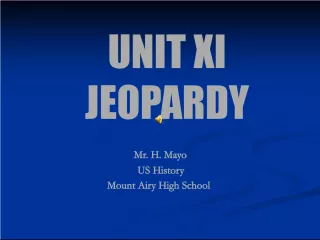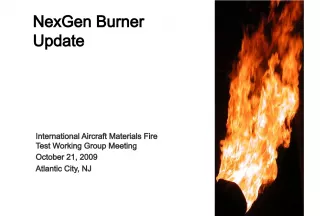Civil War Unit Test Preparation and Group Newscast Script Review


In this "Do Now," students are instructed to record important information regarding the upcoming Civil War unit test in their agendas, including key topics to study such as life in
- Uploaded on | 3 Views
-
 ashtonchen
ashtonchen
About Civil War Unit Test Preparation and Group Newscast Script Review
PowerPoint presentation about 'Civil War Unit Test Preparation and Group Newscast Script Review'. This presentation describes the topic on In this "Do Now," students are instructed to record important information regarding the upcoming Civil War unit test in their agendas, including key topics to study such as life in. The key topics included in this slideshow are . Download this presentation absolutely free.
Presentation Transcript
Slide1Do Now Record in your Agenda : Civil War unit test on Friday (things to study: life in North/South, events leading to the war, key battles/events of the war) Get out your group’s newscast script
Slide2The Road to WarMajor Events leading to the American Civil War
Slide3Slavery Caused the Civil War The issue of slavery divided the North and the South in the 1800s Slavery had existed in all 13 colonies at one point in time (the first slaves had arrived in 1619 in the colony of Jamestown) Individual states could abolish slavery (Rhode Island was the first to do so in 1774– before it was even a state; it was a colony at the time– most northern states had abolished slavery by 1804) It could be outlawed in the whole country– but that would have taken a law passed by Congress.
Slide4Why did Congress Never Outlaw Slavery? Congress is divided into the House of Representatives (based on population) and Senate (2 per state) By 1850, the Northern population was far greater than the Southern population– meaning there were more Northern representatives in the House– and meaning that an anti-slavery bill could easily pass in the House. Advantage? As long as the # of Northern and Southern states remained equal, then the number of Northern and Southern Senators would remain equal in the Senate– meaning there was little chance of an anti-slavery bill passing in the Senate. Advantage? If a bill only passes in the House, but not the Senate, then it can’t become a law. So, this is why Congress not able to pass a law abolishing slavery before the Civil War. Keeping the # of slave and free states at an equal number was very important to slave holding states for this reason.
Slide5How did Slavery Cause the CivilWar? Look at your How did slavery cause the Civil War? concept map. 8 different causes of the Civil War appear on the lines leading to each circle. As you learn about each of these, think about how slavery was the basis of the cause. You will be prompted to fill the circle for that cause with your visualization. No stick figures!
Slide6Missouri Compromise (1820) Missouri Compromise (1820) Drafted by Henry Clay of KY Missouri enters as a slave state Maine enters as a free state The # of free and slave states remains equal– thus, the # of Senators free and slave remain equal Line drawn through Louisiana Territory at 36 latitude: slavery would be allowed in new states only below this line
Slide7Missouri Compromise (1820)Update your Concept Map!
Slide8Compromise of 1850 The Missouri Compromise was successful for about 30 years Recall: with the discovery of GOLD in California in the late 1840s that thousands of people rushed to CA in hopes of striking it rich The population of California grew so rapidly that by 1850 it had applied to join the country as a state Since the MO Compromise line was drawn only through the Louisiana Territory, the question became: would CA enter as a free or slave state? (either way, CA would upset the balance in the Senate)
Slide9Compromise of 1850 Recall: the U.S. had recently provoked Mexico into war and had won a significant amount of land with the Treaty of Guadalupe Hidalgo to end the Mexican American War
Slide10Compromise of 1850 Like the MO Compromise, this compromise was drafted by Henry Clay of KY California entered as a free state The rest of the Mexican Cession land (NM and UT territories) would be open to slavery The slave trade was ended in the nation’s capital (Washington, D.C.)– but slave owners there could keep their slaves A stricter fugitive slave law was enacted– obligating Northerners to return runaway slaves to Southerners
Slide11Compromise of 1850
Slide12Uncle Tom’s Cabin In 1852, Harriet Beecher Stowe (a northern abolitionist woman) published a novel, Uncle Tom’s Cabin Although fiction, the novel depicted the cruelties of slavery
Slide13Uncle Tom’s Cabin Stowe’s novel was widely popular in the North– and sparked outrage in the South In 1862 (during the War) Stowe met President Lincoln who supposedly remarked that she “was the little lady who made this big war.”
Slide14Kansas-Nebraska Act (1854) The Kansas-Nebraska Act is an example of political “wheeling-and- dealing” Illinois Senator Stephen Douglas supported building a railroad to connect the Eastern U.S. to the Pacific Ocean He wanted the railroad to run from Chicago through the Louisiana Territory Southerners wanted the railroad to originate in a Southern city and not Chicago Douglas fashioned a deal: If the Southerners agreed to let the railroad run from Chicago then Douglas would help overturn the ban on slavery above the MO Compromise line
Slide15Kansas-Nebraska Act (1854) In 1854, Congress passed the Kansas- Nebraska Act 1. The remainder of the Louisiana Purchase land ( all of it north of the MO Compromise line ) would be divided into 2 territories: Kansas Territory and Nebraska Territory 2. The issue of slavery would be decided in both territories by popular sovereignty – the people in each territory would decide whether to be free or slave by voting on the issue 3. The KS-NE Act eliminated the MO Compromise line
Slide16Bleeding Kansas Anti-slavery and pro-slavery people rushed to both Kansas and Nebraska so they could be counted in the vote Violence broke out between the two factions
Slide17Bleeding Kansas In 1856, white abolitionist (from New England) John Brown led a raid on a pro- slavery settlement in Kansas In what became known as the Pottawatomie Creek Massacre, Brown and his sons murdered 5 pro-slavery men Brown managed to evade capture and claimed he acted on the orders of God
Slide18Bleeding Congress Blood was not only spilled in Kansas but on the floor of the Senate in Washington as well The “Sumner- Brooks Affair” of 1856
Slide19The Dred Scott Case In 1857, the Supreme Court ruled on the case involving a slave, Dred Scott, who had traveled to and lived in Illinois (free state) and Wisconsin (free territory) Upon his master’s death, when he was transferred as property to his master’s widow, Scott sued in court for his freedom based on his having lived in free areas The Supreme Court’s decision was a blow to abolitionists The Court ruled that Scott was not a citizen– and neither was any African American (free or slave)
Slide20The Dred Scott Case The Court further ruled that Scott was not free because he had traveled to free soil as property Finally, the Court ruled that the MO Compromise ban on slavery was unconstitutional– Congress could not ban slavery in any territory
Slide21Raid at Harper’s Ferry Recall John Brown from the Pottawatomie Creek Massacre Now in Virginia in 1859, Brown wanted to start a slave rebellion He and a small group of men broke into the national arsenal at Harper’s Ferry to steal weapons to arm the slaves U.S. Army troops under the leadership of Col. Robert E. Lee captured Brown and his men Brown was convicted of treason and sentenced to death
Slide221860 Election of Lincoln 4 candidates for President Republican: Abraham Lincoln Northern Democrat: Stephen Douglas Southern Democrat: John C. Breckinridge (of KY) Constitutional Union: John Bell
Slide231860 Election of Lincoln Lincoln’s campaign position on slavery: slavery could continue where it already existed BUT it could not expand into new states/territories This position frightened Southerners As a result of Lincoln’s election, Southern states begin to secede (break away from the U.S.) SC is first, with 11 total states by 1861
Slide24Do Now Take a sheet of notebook paper from my stool Write The Road to War Pop Quiz at the top of the page Put your name and block on the second line. Number 1-10 Take out your pink Road to War packet Turn in your notebook to the How Did Slavery Cause the Civil War? concept map Study for your Pop Quiz
Slide251.Why didn’t Congress outlawslavery before the Civil War? 2. In the Missouri Compromise, Missouri was added as a ____ state and Maine as a _____ state. 3. In the Compromise of 1850, California entered the Union as a _____ state and the Mexican Cession would be open to ______. 4. What did Abraham Lincoln say about the author of “Uncle Tom’s cabin? 5. Slavery was to be decided by voting as a result of the _____. 6. Why did violence break out in Kansas and Nebraska? 7.In 1856, _______ led a raid known as the Pottawatomie Creek Massacre. 8.In 1857, the _____ ruled that Dred Scott was not a free man and neither was any ____.. 9. The ___also ruled that a ban on slavery was ------. 10. Explain Abraham Lincoln’s position on slavery.
